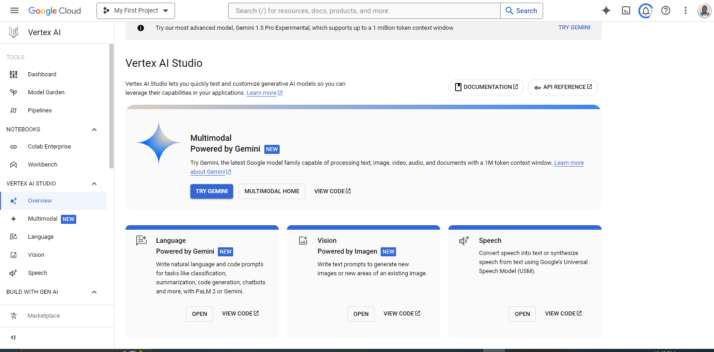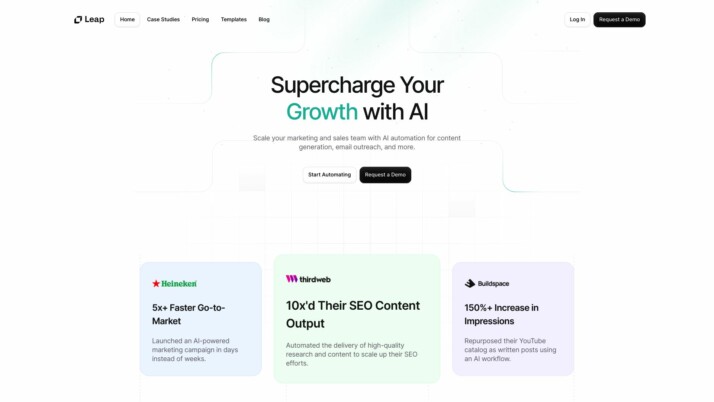Vertex AI vs. Leap AI: Comparing Enterprise and No-Code AI Platforms
AI development platforms have transformed the landscape of machine learning and application creation. Vertex AI vs. Leap AI represent two distinct approaches to empowering organizations with AI capabilities. This comparison delves into the strengths and limitations of each platform, exploring their features, ease of use, and target audiences. We’ll examine how Vertex AI’s enterprise-grade tools cater to complex, multimodal AI projects, while Leap AI focuses on democratizing AI development through no-code solutions. By analyzing these platforms alongside SmythOS, we’ll uncover which solution best meets the diverse needs of developers, business leaders, and AI enthusiasts seeking to harness the power of artificial intelligence.
Vertex AI Overview
Vertex AI delivers a comprehensive machine learning platform for training and deploying AI models at scale. Google’s platform integrates powerful foundation models like Gemini with robust MLOps tools, enabling organizations to build sophisticated AI applications.


Screenshot from Vertex AI studio.
Vertex AI excels at handling complex, multimodal data inputs including text, images, audio, and video. The platform’s Gemini models showcase advanced reasoning capabilities, enabling nuanced interactions and problem-solving across diverse use cases. For enterprises seeking to operationalize AI, Vertex AI provides end-to-end support from data preparation to model deployment and monitoring.
Vertex AI excels at handling complex, multimodal data inputs including text, images, audio, and video. The platform’s Gemini models showcase advanced reasoning capabilities…
Key strengths include the Model Garden for discovering and customizing pre-trained models, advanced model registry and versioning, and tools for responsible AI development. Vertex AI also offers industry-specific solutions like MedLM for healthcare applications. However, the platform’s sophistication may present a steeper learning curve for beginners compared to more simplified no-code tools.
Vertex AI integrates seamlessly with Google Cloud services and supports deployment across various environments. This flexibility, combined with enterprise-grade security and scalability, positions Vertex AI as a robust choice for organizations with significant AI ambitions and technical resources. While powerful, prospective users should weigh the platform’s complexity against their in-house AI expertise and project requirements.
Leap AI Overview
Leap AI empowers users to create sophisticated AI workflows without coding expertise. The platform’s drag-and-drop interface enables rapid development of AI-powered applications, from chatbots to content generators. Leap AI’s comprehensive SDK support facilitates seamless integration across various programming languages and frameworks.
The platform shines in its extensive template library, offering pre-built solutions for common AI tasks like blog post creation, music generation, and lead summarization. Leap AI supports a diverse array of AI models, including OpenAI GPT, Mistral 7b, and Stable Diffusion XL, catering to a wide range of AI applications.


Screenshot of Leap AI Website
Leap AI empowers users to create sophisticated AI workflows without coding expertise. The platform’s drag-and-drop interface enables rapid development of AI-powered applications, from chatbots to content generators.
Leap AI stands out with its robust integration capabilities, connecting effortlessly with popular tools like Slack, Hubspot, and Zapier. This versatility allows businesses to incorporate AI into existing workflows seamlessly. The platform’s user-friendly dashboard streamlines the process of designing, testing, and deploying AI workflows.
While Leap AI offers powerful features for AI development, it may present a learning curve for users new to AI concepts. The platform’s focus on no-code solutions, while beneficial for many, could potentially limit advanced customization options for experienced developers seeking granular control over their AI models.
Leap AI’s vision centers on democratizing AI technology, making advanced capabilities accessible to a broader audience. By providing tools for custom model training and fine-tuning, the platform enables users to create highly specialized AI solutions tailored to their unique needs. This approach positions Leap AI as a versatile tool for businesses and individuals looking to harness the power of AI without extensive technical expertise.
Feature Comparison
Vertex AI and Leap AI offer distinct approaches to AI development and deployment. Vertex AI provides a comprehensive machine learning platform with advanced capabilities for handling complex, multimodal data inputs. Its strengths lie in enterprise-grade features like the Model Garden, advanced model registry, and tools for responsible AI development. Vertex AI excels in areas such as explainability, debugging, and scalability, making it suitable for organizations with significant technical resources and AI ambitions.
In contrast, Leap AI focuses on empowering users to create AI workflows without extensive coding knowledge. Its drag-and-drop interface and extensive template library make it more accessible for rapid AI application development. While Leap AI offers powerful features for integration and supports various AI models, it may lack some of the advanced customization options and granular control that Vertex AI provides for experienced developers.
Both platforms have gaps in certain areas. Vertex AI requires coding knowledge for model development, potentially limiting its accessibility for non-technical users. Leap AI, while user-friendly, may present limitations for users seeking highly specialized or custom AI solutions that go beyond its pre-built templates and integrations. The choice between these platforms ultimately depends on the specific needs, technical expertise, and scale of AI projects an organization plans to undertake.
Feature Comparison Table
| Vertex AI | Leap AI | SmythOS | |
|---|---|---|---|
| CORE FEATURES | |||
| Hosted Agents (Dev, Production) | ✅ | ❌ | ✅ |
| No-Code Options | ❌ | ✅ | ✅ |
| Autonomous Agents | ✅ | ❌ | ✅ |
| Explainability & Transparency | ✅ | ❌ | ✅ |
| Debug Tools | ✅ | ❌ | ✅ |
| Multi-Agent Collaboration | ✅ | ❌ | ✅ |
| Audit Logs for Analytics | ❌ | ✅ | ✅ |
| SECURITY | |||
| Constrained Alignment | ✅ | ❌ | ✅ |
| COMPONENTS | |||
| Huggingface AIs | ❌ | ✅ | ✅ |
| Zapier APIs | ❌ | ✅ | ✅ |
| Data Lakes | ✅ | ❌ | ✅ |
| DEPLOYMENT OPTIONS (EMBODIMENTS) | |||
| DATA LAKE SUPPORT | |||
| Hosted Vector Database | ✅ | ❌ | ✅ |
| Sitemap Crawler | ❌ | ✅ | ✅ |
| YouTube Transcript Crawler | ❌ | ✅ | ✅ |
Best Alternative to Vertex AI and Leap AI
SmythOS stands out as the superior alternative to Vertex AI and Leap AI, offering a comprehensive AI automation platform that combines power and accessibility. Our platform empowers users to create and deploy sophisticated AI agents with unprecedented ease and flexibility.
Unlike Vertex AI’s complex, code-heavy approach or Leap AI’s limited customization options, SmythOS provides a perfect balance of advanced capabilities and user-friendliness. We offer a visual drag-and-drop interface that allows both technical and non-technical users to build complex AI workflows without extensive coding knowledge.
SmythOS provides a perfect balance of advanced capabilities and user-friendliness… a visual drag-and-drop interface that allows… users to build complex AI workflows without extensive coding knowledge.
SmythOS excels in its versatility, supporting a wide range of AI models and integrations. While Vertex AI focuses primarily on Google’s proprietary models and Leap AI offers a more limited selection, our platform integrates seamlessly with various AI providers, including OpenAI, Anthropic, and Hugging Face. This flexibility ensures that users can leverage the best AI technologies for their specific needs.
One of SmythOS’s standout features is its robust multi-agent collaboration capabilities. Unlike Leap AI, which lacks this functionality, and Vertex AI’s more limited offerings, our platform enables the creation of sophisticated multi-agent systems. These AI teams can work together on complex tasks, significantly enhancing efficiency and problem-solving capabilities across various industries.
SmythOS’s standout features is its robust multi-agent collaboration capabilities… our platform enables the creation of sophisticated multi-agent systems.
Furthermore, SmythOS offers unparalleled deployment options. We provide the ability to deploy AI agents as APIs, webhooks, scheduled tasks, or even as ChatGPT plugins. This flexibility, combined with our platform’s scalability and enterprise-grade security features, makes SmythOS the ideal choice for businesses of all sizes looking to harness the full potential of AI automation.
Conclusion
Vertex AI, Leap AI, and SmythOS each offer unique approaches to AI development and deployment. Vertex AI excels in handling complex, multimodal data inputs and provides robust enterprise-grade features. Leap AI focuses on empowering users with no-code AI workflow creation and extensive integration capabilities. However, SmythOS emerges as the superior choice, combining the strengths of both platforms while addressing their limitations.
SmythOS stands out with its intuitive drag-and-drop interface, enabling users to create sophisticated AI workflows without extensive coding knowledge. Unlike Vertex AI’s steep learning curve, SmythOS democratizes AI development, making it accessible to a broader audience. While Leap AI offers templates, SmythOS goes further by providing a comprehensive ecosystem of over 300,000 integrations, surpassing Leap AI’s integration capabilities.
What truly sets SmythOS apart is its versatility and deployment options. The platform’s “Create Once, Deploy Anywhere” approach allows users to seamlessly integrate AI agents into multiple environments, from chatbots to APIs and scheduled tasks. This flexibility, combined with support for various AI models and data sources, positions SmythOS as the ideal solution for businesses seeking to harness AI’s full potential across their operations.
For those ready to experience the future of AI development and deployment, we invite you to explore SmythOS. Create a free account today and discover how our platform can revolutionize your approach to AI, offering unparalleled flexibility, scalability, and ease of use. With SmythOS, you’ll be equipped to tackle complex AI challenges and drive innovation in your organization.
Last updated:
Disclaimer: The information presented in this article is for general informational purposes only and is provided as is. While we strive to keep the content up-to-date and accurate, we make no representations or warranties of any kind, express or implied, about the completeness, accuracy, reliability, suitability, or availability of the information contained in this article.
Any reliance you place on such information is strictly at your own risk. We reserve the right to make additions, deletions, or modifications to the contents of this article at any time without prior notice.
In no event will we be liable for any loss or damage including without limitation, indirect or consequential loss or damage, or any loss or damage whatsoever arising from loss of data, profits, or any other loss not specified herein arising out of, or in connection with, the use of this article.
Despite our best efforts, this article may contain oversights, errors, or omissions. If you notice any inaccuracies or have concerns about the content, please report them through our content feedback form. Your input helps us maintain the quality and reliability of our information.
